12 Top Winter Bird Feeding Tips
Updated: Jan. 04, 2024
Birds change their eating habits as colder weather rolls in. But you can help your feathered friends by following these winter bird feeding tips.
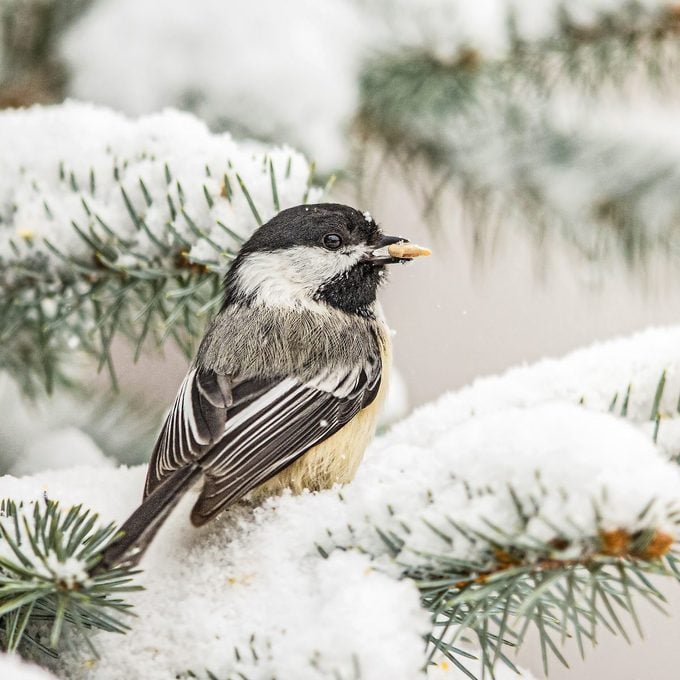
Whether we do it consciously or not, we shift what we eat to adapt to the change in seasons. When it comes to what birds munch in winter, the same principles apply, although their quest for survival is far more perilous than ours. The cold weather requires them to eat much more to stay warm and the snow makes it more difficult for them to actually find the food they need. By following these winter bird feeding tips, you’ll be helping your backyard birds survive and thrive this winter.
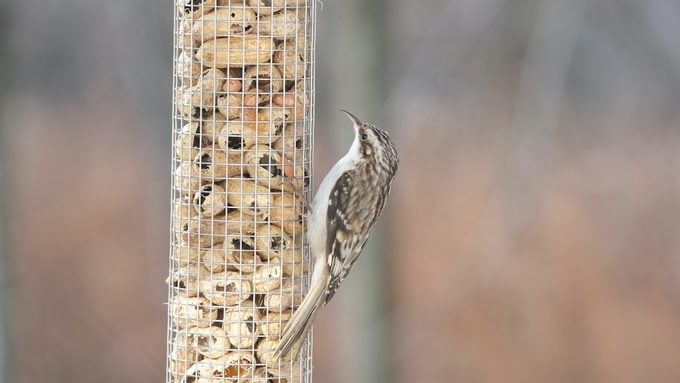
“It comes down to two things: food availability and calorically dense nutrition,” says John Rowden, senior director of bird-friendly communities at the National Audubon Society. “Without the abundance of spring and summer, birds have to work harder to find food and sample more of their environment.”
While birds have quite a few high-activity phases in their lives, including migration, breeding and raising young, limited food supplies make winter more energetically expensive. As temps drop, the foraging behaviors of birds change.
Insects start to disappear and natural seed sources dwindle, forcing birds to use extra energy searching for food, with a lower rate of return. This means certain parts of their diet ramp up, such as snacking on high-calorie seeds and remaining fruits.
And for most birds, other habits stop, such as hunting bugs. Those that still do eat insects are required to look deeper into cracks and crevices for their prey, which takes a lot of work.
Winter feeding tends to vary depending on whether the bird migrates. Migratory birds put on a layer of fat, just enough to make it through the flight. Then they shift to finding food at their destination. However, birds that stick around not only store up fat; some cache food for later. “It takes more calories to maintain that high internal body temperature when the ambient temperature is so much lower,” says John.
Birds also join flocks to locate lunch. With more birds to find food or watch for predators, the group can be more vigilant in staying safe and possibly collect more food. Flocks also provide further protection, as it’s confusing for the predator when a lot of birds are moving around quickly within close proximity.
Here’s some of the best ways you can help birds as the seasons change.
On This Page
Cram Extra Calories: Offer Suet and High Energy Foods
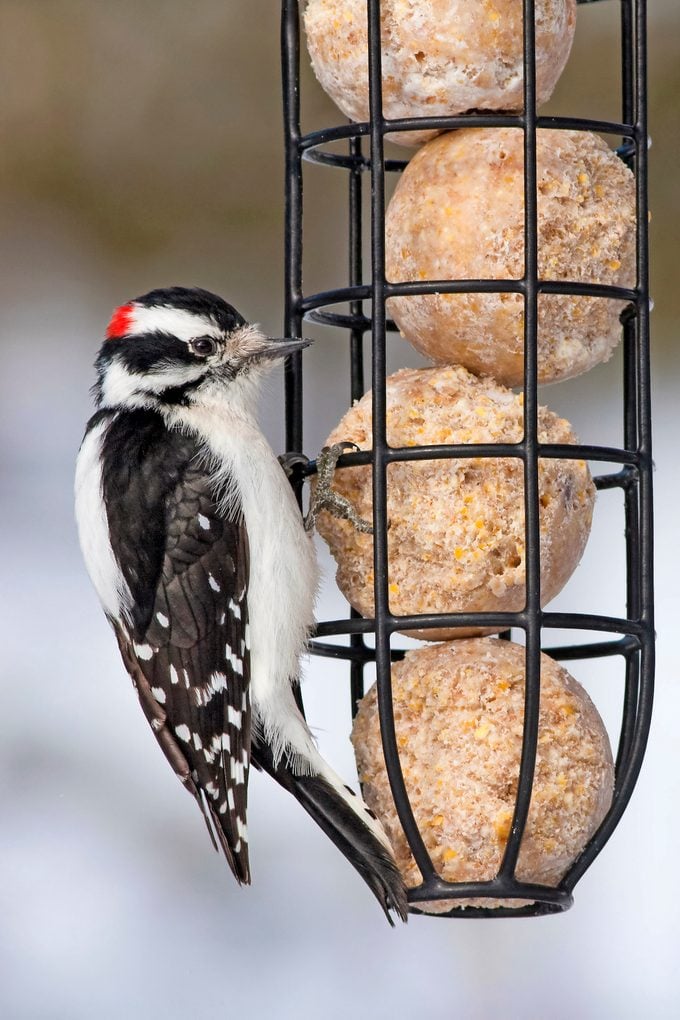
When feeding birds in winter, some foods are better than others. It’s very important for the birds to be able to quickly refuel in the morning after a cold night. Stuff your feeders full of high-calorie, fatty foods, such as peanuts, mealworms, sunflower seeds and suet (all of which stay fresh longer with lower temps).
These foods are high in the fats the birds need and are very easy for a bird to quickly eat with little effort.
Offer suet to birds all winter long. This is probably the best way for birds to get a quick energy boost and build fat reserves for long, cold nights. Serve store-bought suet cakes or make your own suet.
“I’ve fed suet blocks to birds for many years. But a less expensive way to satisfy their suet appetite is to simply spread lard on the bark of trees. They love it, and it’s a fun way to watch them,” says Birds & Blooms reader Bruce Schaffner of Cochrane, Wisconsin.
Check out the types of winter finch birds you should know.
Birds Love Fruit in Winter
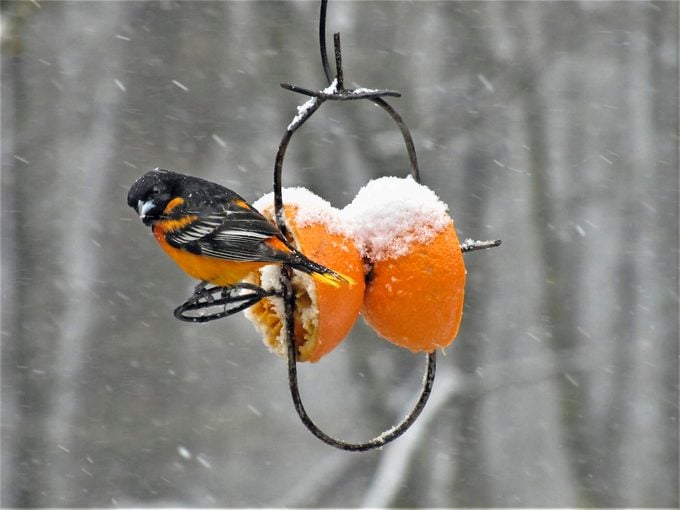
“I offer apples, grapes, cherries and oranges—whatever is on sale at the grocery store. Cut round fruits, like apples and oranges, into 1/2-inch disks to make it easier for birds to eat,” says reader Ron Adler of St. Peters, Missouri.
Also, plant these trees and shrubs with berries for birds.
Feed Birds in Winter Even if You Can’t Get to Feeders
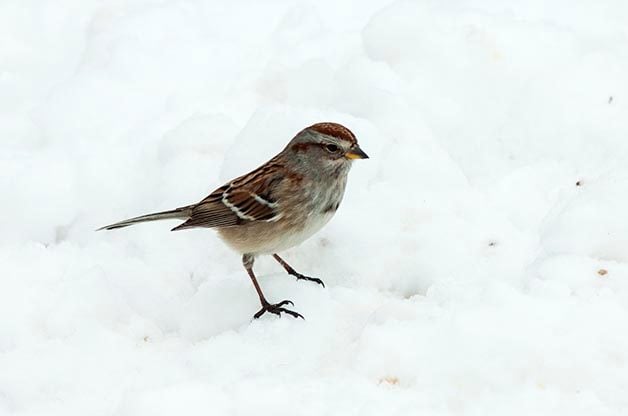
Just because the snow and ice is keeping you from getting to the feeders doesn’t mean you have to stop feeding birds in winter. Consider just tossing some seed out on your deck, patio, or in your yard. The birds don’t mind and some species like cardinals and juncos will be very appreciate of being able to feed on the ground.
“I fill an old birdbath with seed. It attracts a lot of ground-feeding birds that typically stay away from feeders. Plus it keeps the sparrows from hogging your feeder,” says reader Liza Peniston of Augusta, Kansas.
Do robins migrate and fly south in winter?
Provide Fresh Water
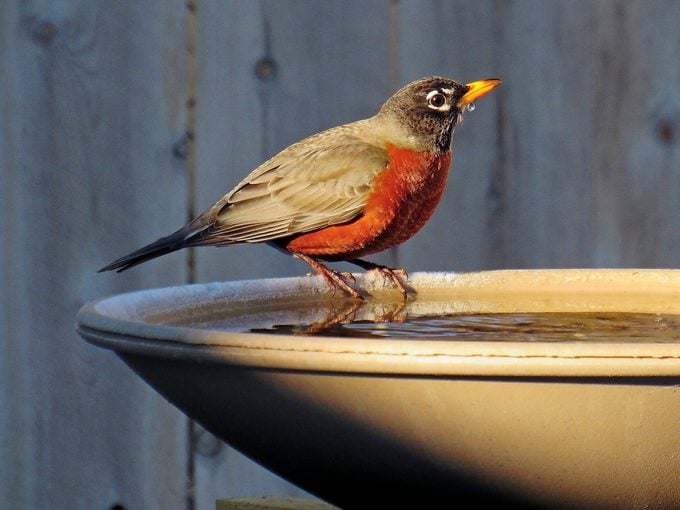
As important as food is to birds in winter, water is even more important. Once natural water sources freeze, it becomes very difficult for birds to find water. By putting a heater in your current bird bath or buying a heated bird bath, you can help birds find water more easily. A bird bath is great addition to your backyard no matter what time of year it is!
Feed Birds Items From Your Kitchen
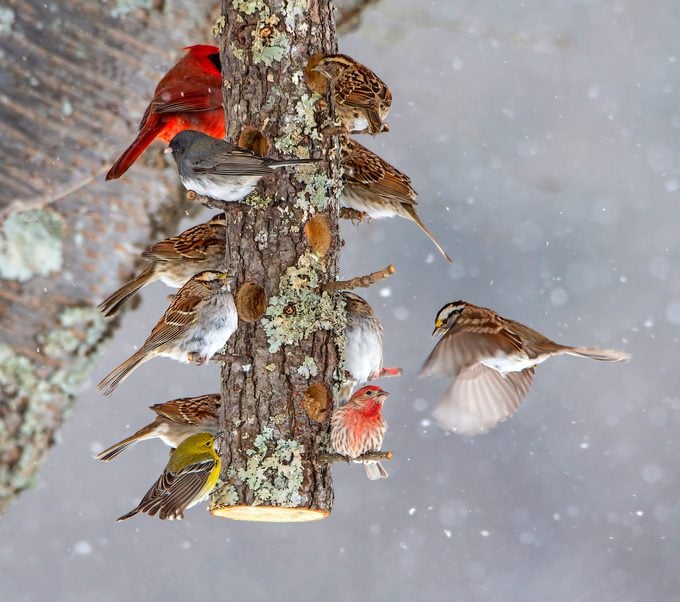
Offer cooked pasta and rice for jays, woodpeckers and titmice. Peanut butter attracts chickadees and woodpeckers. And put out some raisins for a few surprise cold-weather visitors,” says reader Ellie Martin Cliffe of Milwaukee, Wisconsin.
Check out 10 foods you aren’t feeding birds yet.
Make a DIY Birdseed Wreath
Make grapevine wreaths and then decorate them with suet balls, popcorn, cranberry garland and dried fruit for winter bird feeding. They’re a hit with birds and squirrels,” say readers Jay and Paula Johnson of Duluth, Minnesota.
Learn the truth about winter bird myths.
Fill Feeders Daily
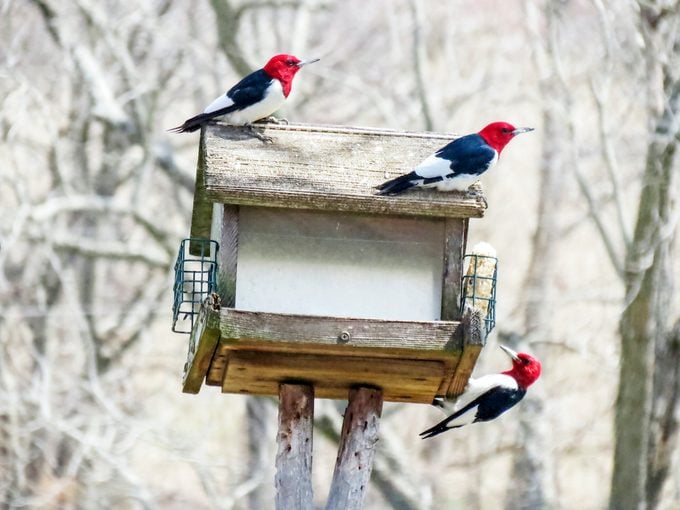
Make sure you fill your backyard bird feeders daily if you can, preferably in late afternoon, to give the birds a boost before they roost for the night. A few days of empty feeders and birds will quickly disappear for better foraging areas. (They have to go where the food is, after all!)
“Hang feeders in a place you can easily access. It’s so easy to refill them often when you don’t have to walk through snow or ice,” says reader Joann Sklarsky of Johnstown, Pennsylvania.
Learn how to create winter shelter for birds.
Spread Feeders Around
To get the most winter bird traffic in your backyard, place your feeders at varying heights and locations, including in or near trees and shrubs, where birds won’t be as vulnerable to predators.
Offer More Than One Type of Food
Provide a variety of foods to attract more species. To save money, buy birdseed in bulk.
“For winter bird feeding, I buy a 50-pound bag of chicken scratch feed and a 25-pound bag of black oil sunflower seed from the local co-op. I mix them together in a large container with a tight lid. It creates a quality mix for less than $25!” says reader Tom Baldwin of Hatfield, Arkansas.
Clean Off Snow and Ice
Brush snow and ice off feeders during and after storms to keep the food accessible to hungry birds.
Where do birds go during a storm?
Don’t Cut Back Flowers
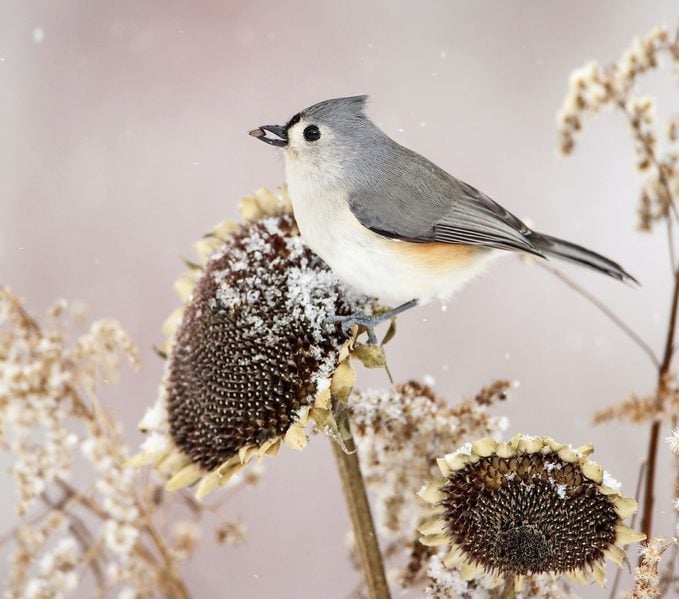
Feed birds from your garden in winter. Attracting birds in winter is easy to do by leaving the spent flowers of summer and fall-flowering perennials alone after the flowers fade, allowing them to form seed. As a bonus, these plants also add texture to an otherwise barren landscape.
Cut back on fall cleanup to provide natural insect and seed sources for birds. Reduce deadheading and keep leaf litter and brush around. “I leave seed-bearing flowers in the garden instead of cutting them back in fall,” says reader Judy Roberts of Graytown, Ohio.
Some Hummingbirds Stick Around in Winter
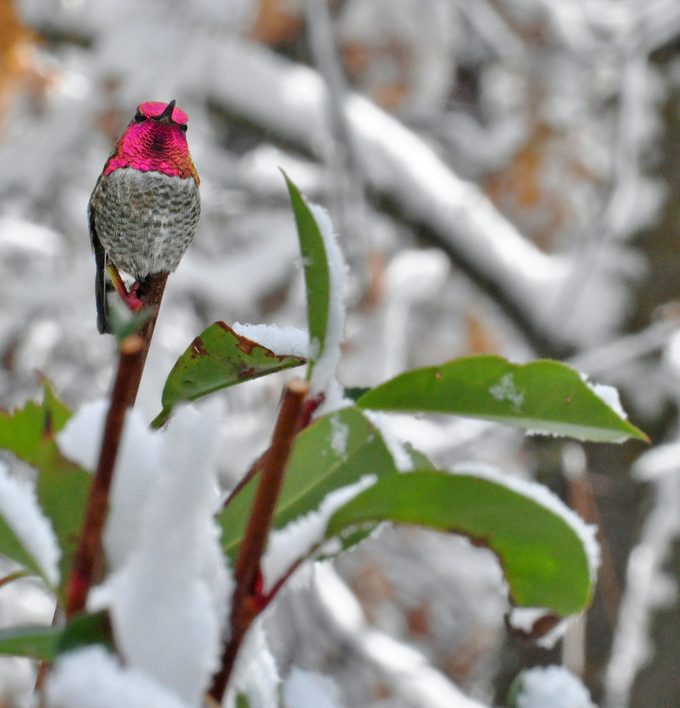
“Hummingbirds visit us year-round, so when the temps are below freezing I hang a cluster of Christmas tree lights under my feeders. It provides enough heat to keep the sugar-water from freezing,” says reader Sharon Mayhew of Vancouver, Washington.
To find out more about your local birds and what they eat in winter, visit audubon.org/birdguide.
